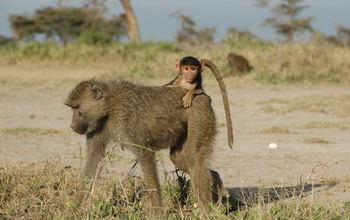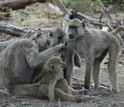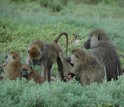Hola amigos: A VUELO DE UN QUINDE EL BLOG., El trauma infantil puede tener efectos sobre la salud de los adultos y la supervivencia en los seres humanos de gran envergadura, los estudios han demostrado. Ahora, una nueva investigación del mismo es cierto para los babuinos salvajes.
Las personas que sufren de abuso infantil, negligencia y otras características de una infancia difícil son más propensos a desarrollar enfermedades del corazón, diabetes y otros problemas de salud más adelante en la vida, incluso después de los acontecimientos estresantes anteriores han pasado, según la investigación.
Un nuevo estudio revela que los babuinos salvajes que sufren múltiples desgracias durante los primeros años de vida, tales como la sequía o las pérdidas de sus madres, a llevar una vida mucho más cortos - hasta una diferencia de 10 años en la esperanza de vida en comparación con sus compañeros más afortunados.
Las personas que sufren de abuso infantil, negligencia y otras características de una infancia difícil son más propensos a desarrollar enfermedades del corazón, diabetes y otros problemas de salud más adelante en la vida, incluso después de los acontecimientos estresantes anteriores han pasado, según la investigación.
Un nuevo estudio revela que los babuinos salvajes que sufren múltiples desgracias durante los primeros años de vida, tales como la sequía o las pérdidas de sus madres, a llevar una vida mucho más cortos - hasta una diferencia de 10 años en la esperanza de vida en comparación con sus compañeros más afortunados.
More information....
Baboons who experience drought, loss of mothers, live shorter lives
 Credit and Larger Version |
April 19, 2016
Childhood trauma can have far-reaching effects on adult health and survival in humans, studies have shown. Now, new research finds the same is true for wild baboons.
People who experience childhood abuse, neglect and other hallmarks of a rough childhood are more likely to develop heart disease, diabetes and other health problems later in life, even after the stressful events have passed, previous research shows.
A new study finds that wild baboons who experience multiple misfortunes during the first years of life, such as drought or losses of their mothers, live much shorter lives -- up to a 10-year difference in life expectancy compared with their more fortunate peers.
Baboon and human similarities
"This suggests that human adult health effects from childhood stresses are not simply products of the modern environment, but have likely been present throughout our evolutionary history," said George Gilchrist, program director in the National Science Foundation (NSF) Division of Environmental Biology, which funded the research.
The results are important because they show that early adversity can have long-term negative effects on survival even in the absence of differences in smoking, drinking or medical care -- factors commonly evoked to explain similar patterns in humans, said Jenny Tung, an evolutionary biologist at Duke University.
Tung co-authored a paper reporting the findings, published this week in the journal Nature Communications.
The conclusions come from a long-term study of 196 wild female baboons monitored on a nearly daily basis between 1983 and 2013 near Amboseli National Park in southern Kenya.
Life isn't easy for a wild baboon, the scientists found. Like many animals on the African savanna, baboons endure drought, overcrowding, disease and predation.
Sources of early adversity
The researchers focused on six potential sources of early adversity. Some baboons, for example, saw very little rainfall in their first year of life, or experienced stiff competition for resources because of sibling spacing or rising numbers within their group. Others lost their mothers to death or illness, or had moms with lower rank or little social support.
More than three-fourths of the baboons in the study had at least one of the six early risk factors; 15 percent had three or more.
Baboons who lost their mothers before age four, or whose next-born sibling arrived before they were fully weaned, were found to be the most vulnerable.
For baboons, like humans, the tougher the childhood, the higher the risks of premature death later in life.
Young females who experienced just one or no adverse events -- a group the researchers nicknamed the "silver spoon kids" -- generally lived into their late teens and early twenties, whereas those that endured three or more adverse events often died by age nine.
The "bad luck" babies not only lost more than 10 years from their adult lives, they also had fewer surviving offspring. "It's a snowball effect," said co-author Elizabeth Archie of the University of Notre Dame.
Two females named Puma and Mystery, for example, were both born during years of little rainfall, and raised by low-ranking moms who died before the youngsters' third birthdays.
Puma eventually met her end at age seven in the jaws of a leopard. Mystery lived until her disappearance at age 14, presumably to a predator, leaving behind a single infant who died shortly thereafter.
Childhood stress in baboons -- and humans
Some researchers studying the effects of childhood stress on adult human health pin the blame on differences in medical care or risky behavior. People who had troubled childhoods, the thinking goes, are more likely to turn to drugs, alcohol or other coping mechanisms that are bad for their health.
But wild baboons don't smoke or binge on junk food, and they don't carry health insurance. This supports the idea that differences in lifestyle and medical care are only part of the story, said co-author Susan Alberts of Duke.
Baboon females that experienced the most misfortune in their early years were also more socially isolated as adults, suggesting that social support may also be at play.
Along with paper co-author Jeanne Altmann of Princeton, the team plans to investigate how some baboons manage to overcome early adversity. It could be that those who form and maintain supportive relationships as they grow older are better able to survive and thrive, Archie said.
Baboon DNA is 94 percent similar to that of humans, which indicates these patterns could be deeply rooted in primate physiology, the researchers believe.
| -- | Cheryl Dybas, NSF (703) 292-7734 cdybas@nsf.gov |
| -- | Robin Smith, Duke University (919) 681-8057 robin.a.smith@duke.edu |
Investigators Jenny Tung
Susan Alberts
Related Institutions/Organizations Duke UniversitySusan Alberts
Related Awards #1405308 EAGER: New Methods for Genomic Analysis of Noninvasive Samples
Total Grants $292,778
Related WebsitesNSF Discovery: Born during a drought: Bad news for baboons: https://nsf.gov/discoveries/disc_summ.jsp?cntn_id=134000&org=NSF

Members of a baboon group in Amboseli relax and groom together, a primary means of social bonding.
Credit and Larger Version

An adult female baboon with her two-month-old infant, who has just learned to climb on her back.
Credit and Larger Version

Two adult female baboons and an infant rest in the shade while a third female approaches.
Credit and Larger Version

Two adult female baboons groom together while an adult male and several offspring rest nearby.
Credit and Larger Version

An adult female greets a companion who has a new infant.
Credit and Larger Versión
the National Science Foundation (NSF)
Guillermo Gonzalo Sánchez Achutegui
ayabaca@gmail.com
ayabaca@hotmail.com
ayabaca@yahoo.com
Inscríbete en el Foro del blog y participa : A Vuelo De Un Quinde - El Foro!

No hay comentarios:
Publicar un comentario